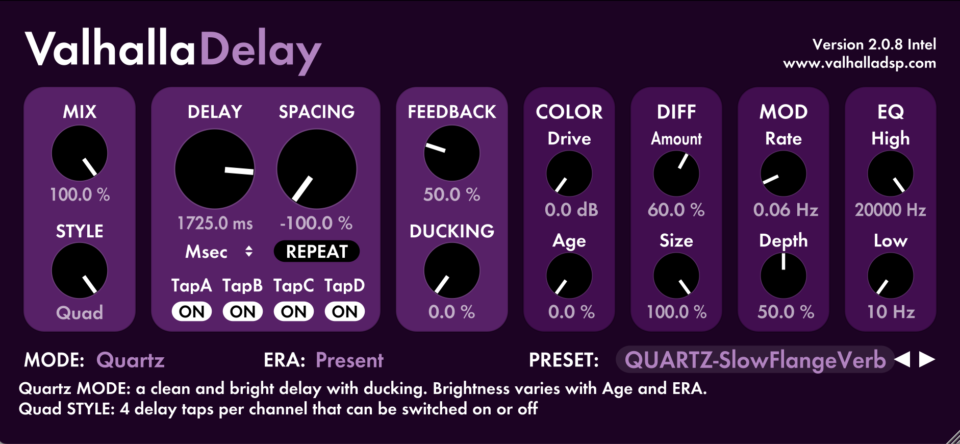ValhallaDelay: Quartz Mode

The ValhallaDelay 2.0.8 update introduced two new delay modes, Quartz and PhaserDDL. I’ve talked extensively about the PhaserDDL mode, so I figured I’d do the same for the Quartz mode.

Feature Overview
At its heart, the Quartz mode is a clean and bright digital delay, with smoothed triangle modulation. It shares some similarities with the Clarity mode, but with a few key differences:
- The Age control in the Quartz mode controls a steep lowpass filter, but with lower orders (i.e. less filtering of the high frequencies) than the Clarity mode. When ERA is set to Future, the Quartz mode disables the filter.
- The Quartz mode has a soft knee limiter controlled by Drive, as does the Clarity mode, but the Quartz mode has less dispersion in the limiter. This allows for signals to loop through the delay continually, without getting “chirpy” or blurred – unless you want blur, in which case the Diffusion section can smooth things out for you.
- The EQ filters (Low Cut and High Cut) and the Age filter are outside of the feedback loop in the Quartz mode. This is a technique I used in most of the ValhallaSupermassive modes. The sonic results: a VERY bright delay sound, where the brightness doesn’t roll off over time.
So, what is Quartz best for?
- 80s/90s digital delays. Most of the “classic” digital delays from the mid-80s and later didn’t have any filters in their feedback path, and the signal quality was high enough that the repeated signal was essentially a delayed copy of the input signal, without much color to speak of.
- Stompbox style flangers. Compact flanger pedals tend to use a BBD, running at very high clock rates. This gives you a flanging signal with plenty of high frequencies, especially as you crank up the feedback.
- Looping! If you are looking for a looper that sounds like a straight repeat of your signal, Quartz is perfect. The signal will decay away over several minutes, without any loss of high frequencies, and with a minimum of blurring.
- Bright reverbs. Turn up the Diffusion amount and size, and Quartz can make some lush reverbs, where the amount of high frequencies is a function of the brightness of the input signal. This works great with an analog synth, where you are riding the lowpass filter cutoff.
Here’s a few examples of the Quartz mode processing drum samples. In the first example, I’m using DMX samples, and the Quartz mode is used for stereo widening of the clap, for the flanging on the toms/hi hats/rimshots, and for a flanged eighth note echo using the Quad style for some deep through-zero flanging:
In the second example, Don Gunn programmed Linn drum samples in Live. He’s using Quartz for the snare reverb, the flanging on the toms, and widening of the clap sound:




